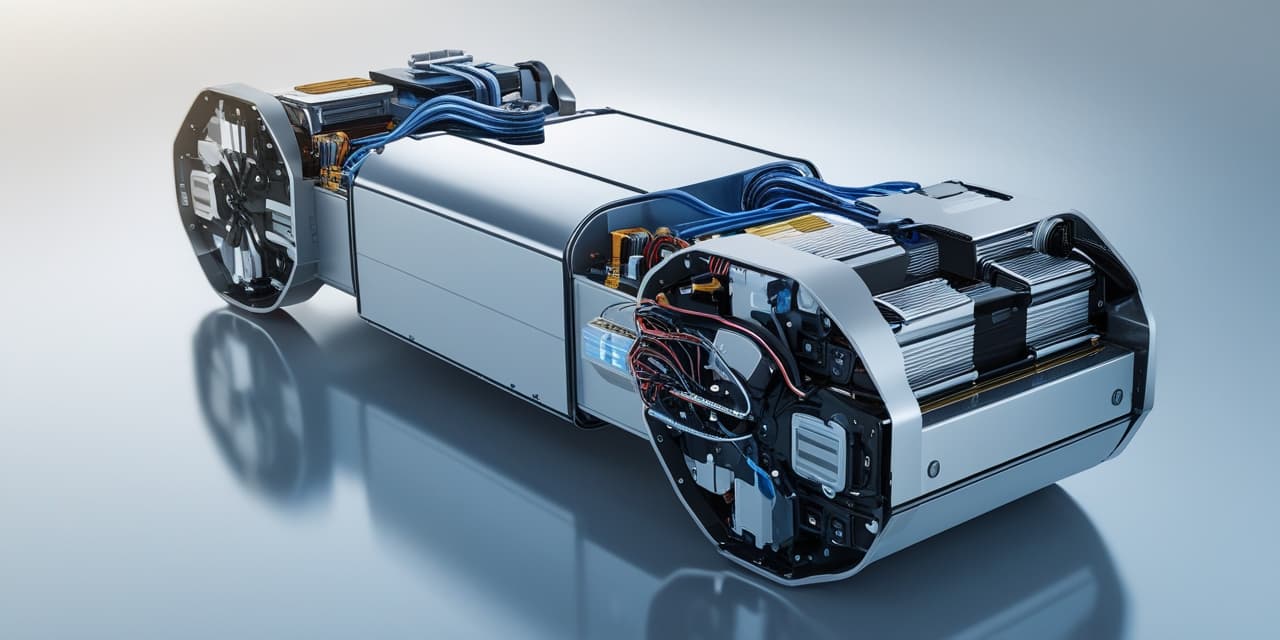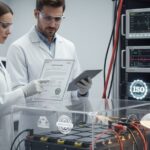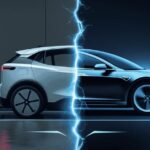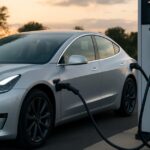You use an amazing energy storage system when you get into an electric car. A lithium battery pack quietly powers your EV. This battery pack results from many years of scientific and engineering work.
As an EV owner or fan, knowing about this technology is helpful. It can help you make good choices and get the most out of your electric car.
I have spent years studying and working with EV batteries. I can tell you that not all lithium batteries are the same. The chemicals inside your battery pack greatly affect how far you can drive and how fast it charges. They also impact safety and how long the battery lasts.
This guide will give you helpful information. Whether you’re buying a new EV, trying to make your current car’s battery last longer, or just curious, it’s for you.
In this article, we will look at different lithium battery types used in EVs today. We will compare how they perform and discuss their safety features. We will also give you tips to make your battery last longer.
You will learn about systems that control battery temperature. You will understand why some batteries charge faster than others. And you will discover what’s next for this fast-changing technology.
After reading this, you will clearly understand what powers your EV. You will also know how to get the most from this important part. Let’s explore the interesting world of EV lithium battery technology.
Understanding Lithium Battery Fundamentals
Let’s understand how lithium batteries work in your EV. Lithium-ion batteries store and release energy using a simple electrochemical process.
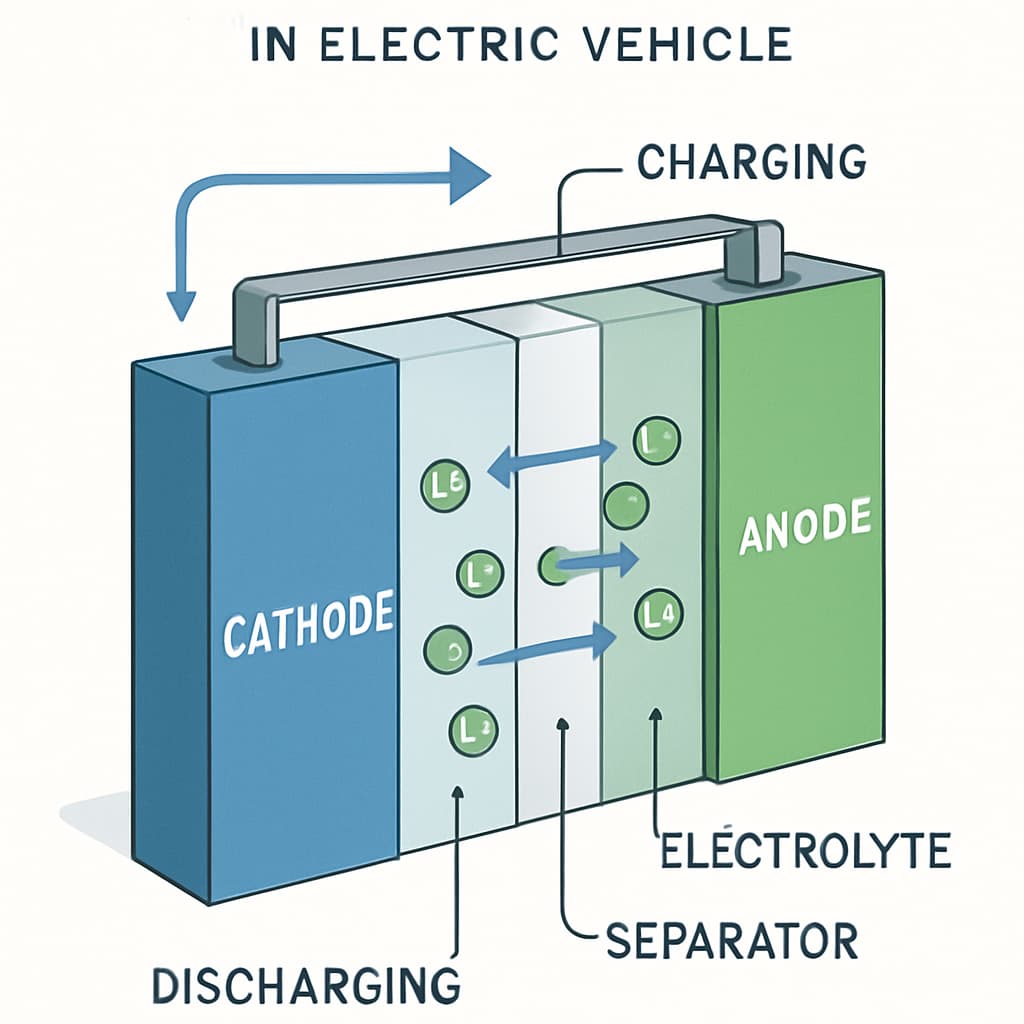
An electric vehicle (EV) battery has four main parts:
- Cathode: This is the positive side of the battery. Lithium ions collect here when the battery is powering your car. The type of material used in the cathode makes different batteries unique.
- Anode: This is the negative side. It’s usually made of graphite. When the battery is charged, the anode stores lithium ions.
- Electrolyte: This liquid or gel helps lithium ions move between the cathode and anode.
- Separator: This thin wall keeps the cathode and anode from touching, preventing a short circuit. It also lets lithium ions pass through.
1. Charging And Driving
When you charge your EV, electricity pushes lithium ions from the cathode to the anode. The anode stores these ions between layers of graphite. When you drive, the ions move back to the cathode. This movement creates energy that powers your car’s motor.
2. Why Lithium Batteries?
EVs use lithium-based batteries because they store more energy for their size. This means you get more driving range without a heavy battery. Like lead-acid or nickel-metal hydride, other batteries can’t store as much energy. Lithium batteries also hold their charge well when not used. You can recharge them many times without them getting worse.
3. Battery As A Water Tank
Imagine your EV battery like a high-tech water tank. When it’s full, your battery is fully charged. As you drive, you use energy, like drawing water from the tank and plugging in refills.
The size of the tank (called “battery capacity” and measured in kilowatt-hours or kWh) tells you how far you can drive. The width of the pipes (called “power capability”) shows how fast you can speed up and recharge.
4. Next Up: Cathode Chemistries
Now that you understand the basics, let’s look at the different materials used in the cathode. The cathode greatly impacts how your EV performs.
Major EV Battery Chemistries Compared
When considering electric cars, you might not think about battery type first. However, it’s a key factor. It affects your car’s performance, how far it can go, how fast it charges, and how long it lasts.
Let’s examine the main lithium battery types in today’s electric cars. This will help you understand what powers your vehicle.
1. Lithium Nickel Manganese Cobalt Oxide (NMC) Batteries
If you own a high-end electric car with a long range, it likely uses NMC batteries. This type of battery has been the most common in electric vehicles for the last ten years, and for good reasons.
NMC batteries have a part called a cathode. This cathode is made from lithium, nickel, manganese, and cobalt. The amounts of these materials can change. Newer versions have more nickel and less cobalt. This change helps the battery store more energy and costs less to make.
Benefits of NMC Batteries:
- More Energy: NMC batteries store more energy for their weight. This gives your car a longer range without making it heavier.
- Powerful: These batteries can provide a lot of power. This means your car can speed up quickly.
- Works Well in Different Temperatures: NMC batteries perform better in various temperatures compared to some other battery types.
- Reliable: These batteries have been used for many years. Because of this, car makers know how to make them work very well.
Limitations of NMC Batteries:
- More Expensive: Cobalt makes these batteries more costly.
- Ethical Issues: Getting cobalt can sometimes involve human rights problems in certain areas.
- Sensitive to Charging: To make the battery last longer, you should not always charge it to full. Also, try not to let it drain below 20%.
You will find NMC batteries in cars like the Tesla Model 3 Long Range, Nissan Leaf, Chevy Volt, and BMW i3. Many other high-end electric vehicles also use them. If a long driving range is most important to you, a car with an NMC battery might be the perfect fit.
2. Lithium Iron Phosphate (LFP)
LFP batteries have existed for many years but are becoming very popular in electric vehicles (EVs). More EVs are using them because they are safe, last a long time, and cost less.
These batteries use a special part called a cathode made from lithium iron phosphate. This material does not contain cobalt or nickel, making LFP batteries better for the environment and cheaper to make.
Advantages of LFP Batteries:
- Very safe: LFP batteries are very unlikely to catch fire. They resist a problem called thermal runaway, which can cause battery fires.
- Last longer: You can charge these batteries about 2,000 to 4,000 times. This is about twice as many times as other batteries, like NMC.
- Cost less: These batteries do not use expensive metals like cobalt. So, they cost about 20% less than NMC batteries.
- Easy to charge: You can charge them to 100% often. This won’t harm the battery much.
- Good materials: The materials for these batteries are easy to find. There are fewer worries about getting them.
Limitations of LFP Batteries:
- Less energy: LFP batteries store about 30% less energy for their weight than NMC batteries.
- Don’t like cold weather: They lose more range in very cold weather. They also charge slower until they get warm.
- Less power when low: You might notice they don’t perform as well when the battery is below 30% charged.
LFP batteries are now common in cheaper and mid-priced EVs. You can find them in cars like the Tesla Model 3 Standard Range, MG4, Volvo EX30, and all BYD cars. An LFP-powered EV might be perfect for you if you mostly drive short distances. It’s also a good choice if you care more about the battery lasting a long time and costing less than having the longest range.
3. Lithium Nickel Cobalt Aluminum Oxide (NCA)
NCA batteries are like NMC batteries but use aluminum instead of manganese. Tesla has preferred this battery type for many years. However, Tesla is now using LFP batteries more often for their standard-range cars.
Advantages of NCA Batteries:
- Lots of Power: NCA batteries store a lot of energy. This means your electric car can go a long way.
- Quick Acceleration: These batteries can give a lot of power quickly. This helps cars speed up fast.
- Works Well in Heat: NCA batteries perform well even when it’s hot outside.
Limitations of NCA Batteries:
- More Expensive: NCA batteries cost more. This is because they contain cobalt.
- Shorter lifespan: NCA typically offers fewer charge cycles than LFP
- Safety Risk: They are generally not as stable as LFP batteries.
NCA batteries are mostly found in Tesla cars, including older and current models that can travel long distances.
4. Lithium Manganese Iron Phosphate (LMFP)
LMFP is a new type of battery that adds manganese to the LFP battery mix. It aims to be as safe and long-lasting as LFP batteries and offer more energy.
Early information shows that LMFP batteries could provide 15-20% more energy than regular LFP batteries. They retain most of the safety benefits. Some companies are starting to use this battery type, and we believe more cars will soon use LMFP batteries.
Comparison Table: EV Battery Chemistries
| Feature | NMC (Nickel Manganese Cobalt) | LFP (Lithium Iron Phosphate) | NCA (Nickel Cobalt Aluminum) |
|---|---|---|---|
| Energy Density | 150-220 Wh/kg | 90-120 Wh/kg | 200-260 Wh/kg |
| Typical Range | Excellent (250-350+ miles) | Good (200-250 miles) | Excellent (250-350+ miles) |
| Safety | Good | Excellent | Good |
| Thermal Runaway Temp | ~150°C | ~270°C | ~150°C |
| Cycle Life | 1,000-2,000 cycles | 2,000-4,000 cycles | 1,000-1,500 cycles |
| Cold Weather Performance | Good | Fair | Good |
| Fast Charging | Excellent (up to 250kW) | Good (up to 170kW) | Excellent (up to 250kW) |
| Cost | Higher | Lower (20% less than NMC) | Higher |
| Raw Materials | Contains cobalt and nickel | No cobalt or nickel | Contains cobalt and nickel |
| Environmental Impact | Higher (cobalt mining concerns) | Lower | Higher (cobalt mining concerns) |
| Charging Best Practice | 20-80% for daily use | Can charge to 100% regularly | 20-80% for daily use |
| Common Applications | Premium EVs, long-range models | Entry-level EVs, energy storage | Tesla vehicles (primarily) |
| Example Vehicles | Tesla Model 3 Long Range, Nissan Leaf, BMW i3 | Tesla Model 3 Standard Range, MG4, BYD models | Tesla Model S, Model X |
| Future Outlook | Decreasing cobalt content, improving safety | Growing market share, improving energy density | Limited growth, being replaced by NMC in many applications |
Which Chemistry Is Right For You?
The “best” battery chemistry depends entirely on your priorities:
- If maximum range and performance are your top concerns, look for an EV with NMC or NCA batteries.
- If safety, longevity, and lower cost matter more than maximum range, an LFP-powered EV might be the better choice.
- If you frequently drive in very cold climates, be aware that LFP batteries lose more range in freezing temperatures.
- If you prefer to charge to 100% regularly for convenience, LFP offers more flexibility.
Remember, battery chemistry is just one factor in your EV’s overall performance. The battery management system, thermal management, and overall vehicle efficiency also play crucial roles.
Performance Factors That Matter To EV Owners
When you evaluate an electric car, remember that battery performance involves more than just its chemical makeup. Many important things influence how you use an EV battery daily. Let’s look at these features.
1. Energy Density And Range
For most electric car owners, how much power a battery holds is very important. We call this “energy density.” It tells us how much energy a battery can store. We measure it by its weight (Watt-hours per kilogram) or by its size (Watt-hours per liter).
Batteries with higher energy density give your car a longer range. They do this without making the car heavier or taking up more space. This is why car makers are always trying to improve it.
Here’s how common battery types compare:
- NMC: 150-220 Wh/kg
- NCA: 200-260 Wh/kg
- LFP: 90-120 Wh/kg
What does this mean for you? If you worry about your car running out of charge, choose vehicles with NMC or NCA batteries. They usually offer more miles on a single charge. For instance, the Tesla Model 3 Long Range uses NMC batteries. It goes about 40% farther than the Standard Range version, which uses LFP batteries. The long-range battery pack is only about 30% larger.
But energy density isn’t the only thing that matters. Many drivers find that LFP batteries offer enough range for daily driving even though they hold less power. This is especially true if you can charge your car at home overnight.
2. Power Density And Performance
A battery’s “power density” shows how fast it can release its energy. This directly impacts your car’s performance. For example, it affects how quickly your vehicle speeds up, climbs hills, and maintains high speeds.
NMC and NCA batteries usually offer more power than LFP batteries. That’s why you often find them in high-performance electric vehicles (EVs). However, today’s LFP batteries are much better. They now provide enough power for most everyday driving.
You’ll especially notice a battery’s power when you:
- Speed up quickly from a stop.
- Pass other cars on the highway.
- Drive up steep hills.
- Maintain fast speeds.
If you like to drive fast or live in a hilly area, power density will be more important for you. But if you drive calmly on flat roads, it might not be as big of a concern.
3. Charging Speed Capabilities
Your EV’s charging speed mainly depends on its battery type and how its system manages the battery. We measure this speed by how many kilowatts (kW) the battery can take in.
NMC and NCA batteries usually charge faster. This is especially true when they are between 10% and 80% full. LFP batteries generally charge more slowly, particularly in cold weather. However, you can charge LFP batteries to 100% more often without issues.
For example:
- A Tesla Model 3 with NMC batteries might charge up to 250kW at a Supercharger.
- The same Model 3 with LFP batteries might only reach about 170kW.
The “charging curve” is what matters most. This shows how the charging speed changes as the battery fills up. All batteries charge more slowly as they get full, but when they start to slow down, it differs based on the battery’s chemistry and design.
When you’re on a road trip, charging from 10% to 80% is often more important than the highest charging speed. If fast charging is important to you, this is the number to check when you compare different EVs.
4. Temperature Sensitivity
Temperature greatly impacts how well your car’s battery performs. Different battery types react differently to hot and cold weather.
In cold weather:
- All lithium batteries lose some driving range. However, cold affects LFP batteries more.
- Charging speeds slow down until the battery gets warm.
- Warming the battery before charging, called “preconditioning,” becomes important.
In hot weather:
- Batteries might need cooling to prevent damage.
- The car may limit fast charging to protect the battery.
- Lots of exposure to high temperatures can make the battery age faster.
If you live where it gets very hot or very cold, think about how your battery type will perform. In very cold places, NMC or NCA batteries might be better. In hot climates, LFP batteries handle heat better, which can be an advantage.
5. Cycle Life and Longevity
“Cycle life” tells us how many times you can fully charge and discharge a battery before it starts to lose a lot of its capacity. This directly impacts how long your EV battery will last.
LFP batteries are excellent in this area. They typically last for 2,000 to 4,000 charge-discharge cycles before their capacity drops to 80% of what they originally held. NMC and NCA batteries usually offer 1,000 to 2,000 cycles.
What does this mean for you? Imagine your EV can travel 300 miles on a full charge and you drive 12,000 miles each year:
- You will complete about 40 full charge-discharge cycles annually.
- An LFP battery could last 50 to 100 years at this rate. (However, other things will cause it to fail before then).
- An NMC battery might last 25 to 50 years.
In reality, other factors, like the battery aging over time regardless of use, mean most EV batteries will last 10 to 20 years before you need to replace them. LFP batteries will likely last longer than NMC or NCA types.
6. Cost Considerations
The battery makes up a big part of your electric vehicle’s (EV) total price. Different battery types have different costs:
- LFP batteries cost about 20% less than NMC or NCA batteries.
- This price difference will likely grow as the cost of nickel and cobalt (used in NMC/NCA) goes up.
Because LFP batteries are cheaper, many car makers use them in their less expensive EV models. This helps make EVs more affordable and available to more people.
When you look at the total cost of owning an EV, don’t just consider the initial price. Also think about how long the battery is expected to last. An LFP battery might cost less to buy and last longer. This can give you better overall value, even if it offers less driving range.
7. Battery Management System (BMS)
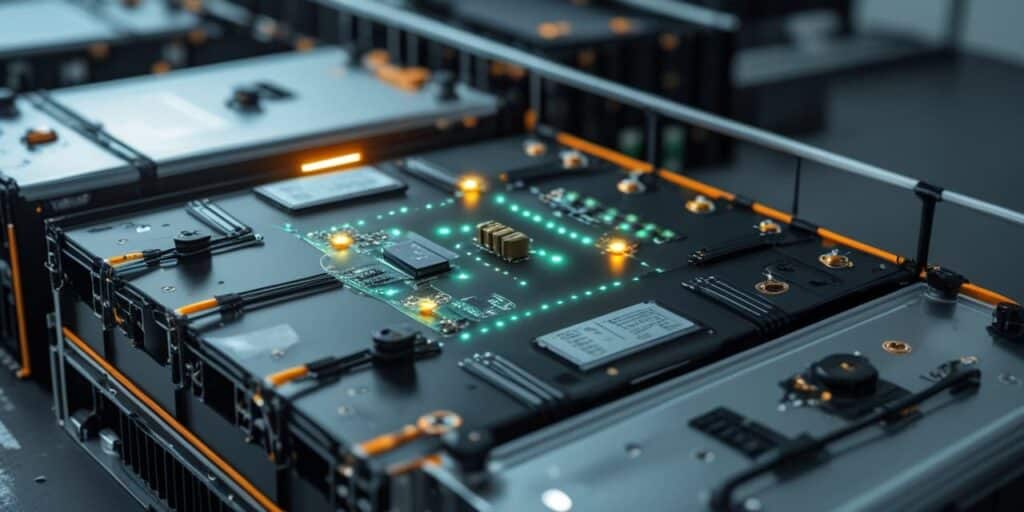
Battery chemistry is very important, but the Battery Management System (BMS) is just as crucial. Think of the BMS as the computer that controls how your battery charges, discharges, and takes care of itself.
A smart BMS can:
- Make your battery last longer by improving how it charges.
- Keep battery cells balanced for better performance.
- Adjust to changes in temperature.
- Guess your remaining driving range more accurately.
- Protect the battery from harm.
Even if two electric vehicles (EVs) have the same battery chemistry, they can perform very differently. This depends on how their BMS is designed. This is why experienced car makers, who have worked with batteries for many years, often provide better real-world performance than newer companies, even with similar battery parts.
Battery Thermal Management Systems
Have you ever felt your phone get hot when it’s charging or running many apps? That’s heat from its lithium battery. In an electric vehicle (EV), the battery pack is much bigger, so it creates a lot more heat.
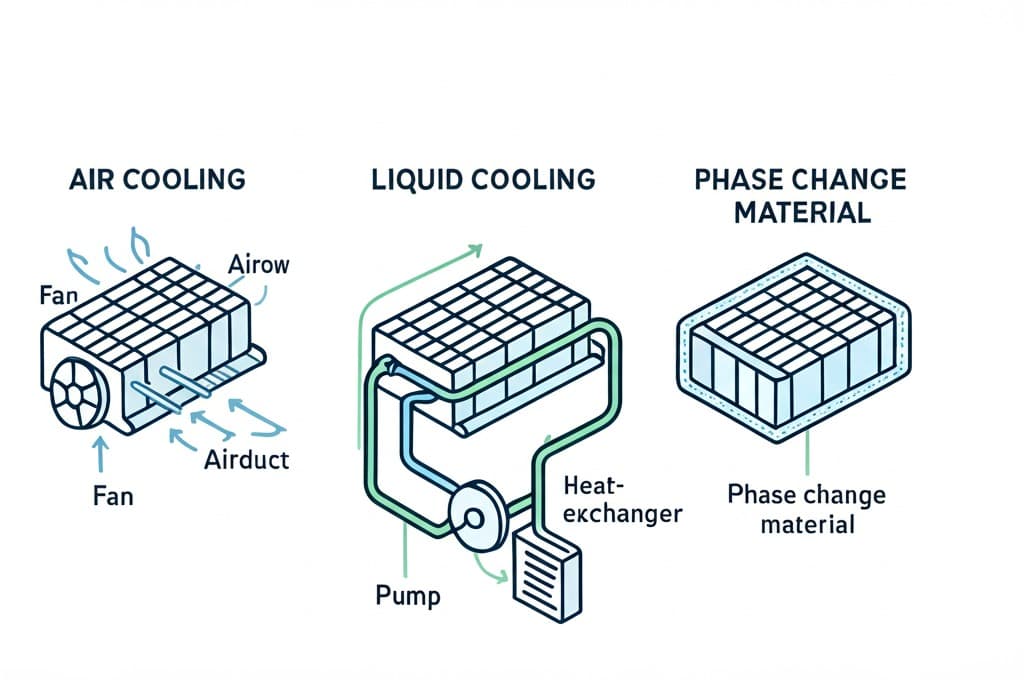
Managing this heat is very important. It’s not just about comfort. Good heat management is key for your battery to perform well, stay safe, and last long.
1. Why Battery Temperature Matters A Lot
Your EV battery works best when its temperature is between 15∘C and 35∘C (59∘F to 95∘F). If the temperature goes outside this range, you can face several issues:
When it’s too cold (below 15∘C/59∘F):
- Your car won’t go as far. In freezing temperatures, the range can drop by 20-40%.
- Charging will be slower.
- The car will accelerate less quickly.
- The battery becomes less efficient due to increased internal resistance.
When it’s too hot (above 35∘C/95∘F):
- The battery will wear out faster.
- In extreme cases, there’s a risk of the battery overheating dangerously (thermal runaway).
- Charging speeds will decrease as the car’s system protects the battery.
- The battery might permanently lose some of its capacity.
2. Air Cooling For EV Batteries
The simplest way to cool an EV battery is by using air. Think of it like the fan in your computer; air blows across the battery cells to remove heat.
How Air Cooling Works:
- Fans move air through special paths inside the battery.
- The battery cells transfer their heat to this moving air.
- The warmed air then exits the battery.
Pros of Air Cooling:
- It costs less and is less complex.
- It makes the battery lighter.
- Fewer parts can break.
- Maintenance is simpler.
Cons of Air Cooling:
- It doesn’t work as well in very hot or very cold weather.
- The battery might not cool evenly.
- It can’t cool the battery much during fast charging.
- It’s less effective at heating the battery when it’s cold.
Air cooling is found in more affordable EVs, like the Nissan Leaf. This system works well enough for average weather and normal driving. However, air-cooled batteries might wear out faster in very hot places or if you frequently fast-charge your car.
3. Liquid Cooling For EV Batteries
Most new electric vehicles (EVs) use liquid cooling. This system does a better job of controlling battery temperature, especially in very hot or cold conditions.
How Liquid Cooling Works:
- A special liquid, like a mix of water and antifreeze, flows through tubes or plates next to the battery cells.
- The liquid soaks up heat from the cells.
- A radiator or heat exchanger then removes this heat from the liquid.
- A pump keeps the liquid moving through the system.
- When it’s cold, the system can also heat the liquid and battery using a heater.
Benefits of Liquid Cooling:
- It controls temperature more effectively.
- The entire battery stays at a more even temperature.
- The battery performs better when fast-charging.
- It can actively warm the battery in cold weather.
- It protects the battery from wearing out too quickly.
Things to Consider:
- It costs more and is more complex.
- It adds a bit more weight to the car.
- Leaks are possible, but they are rare.
- It has more parts that might need maintenance.
You’ll find liquid cooling in most higher-end EVs. Examples include Tesla models, the Ford Mustang Mach-E, and the Volkswagen ID.4. If you live where temperatures are extreme or you often use fast charging, a liquid-cooled battery is a good investment.
4. Phase Change Materials (PCM)
Some newer electric vehicles (EVs) use special materials to help cool their batteries. We call these “phase change materials” or PCMs. These materials soak up or release heat when they change from a solid to a liquid, or vice versa.
How PCM Cooling Works:
- Special materials around the battery cells absorb heat as they melt.
- This helps keep the battery’s temperature steady.
- EV makers often combine PCM cooling with liquid or air cooling systems.
Benefits:
- It keeps the temperature very stable.
- It works on its own, so it uses less energy.
- It adds extra protection against the battery getting too hot (thermal runaway).
Things to Consider:
- It costs more.
- It adds more complexity to the system.
- This technology is still quite new.
PCM cooling is not as common yet, but some new EV designs are starting to use it. It’s especially good at keeping temperatures stable when the battery is working hard, like during frequent fast charging.
5. Smart Temperature Control For Batteries
The most advanced—and expensive—way to manage a battery’s temperature uses “thermoelectric systems.” These devices can actively cool or heat the battery just by using electricity.
How They Work:
- Thermoelectric coolers move heat when you apply electricity. This is called the Peltier effect.
- You can change the direction of heat movement by simply changing the direction of the electric current.
- This allows for very exact temperature control in any situation.
Good Points:
- They offer exact temperature control.
- They react quickly to temperature changes.
- They work well even in very hot or very cold places.
Things to Consider:
- They cost the most.
- They use a lot of energy.
- They are complicated to put into a system.
Thermoelectric systems usually work together with other cooling methods. They provide extra temperature control when it’s needed most.
What To Look For In An EV’s Thermal Management System
When you look at an electric vehicle (EV), think about its temperature control system. This system keeps the battery at the right temperature. Here’s what to check:
- Cooling Method: Liquid cooling is usually better than air cooling. It works especially well in very hot or very cold places.
- Preconditioning: Can you warm up or cool down the battery before you drive or charge it? You can often do this with a phone app. This feature greatly improves the car’s performance and charging speed.
- Smart Charging Prep: When driving to a fast charger, does the car automatically get the battery ready for the best charging?
- Heat Pump: Many newer EVs have a heat pump. It efficiently warms the car’s interior and battery in cold weather, helping the car achieve more range.
- Battery Placement: Batteries located inside the car’s heated or cooled area usually keep a steadier temperature.
The temperature control system might not seem exciting when you buy an EV. However, it significantly affects how your car performs, how it charges, and how long the battery lasts. A good battery thermal management system (BTMS) can make a big difference. For example, a good system can help your battery keep 90% of its power after 8 years. A poor system might see the battery drop to 70% in the same time.
Battery Safety: What You Need to Know
When it comes to EV batteries, safety is a top concern for both car makers and owners. You might see news about EV fires, but modern lithium batteries actually have many safety layers. These layers help them work safely in almost all conditions.
1. Understanding Safety Risks
Lithium batteries pack a lot of energy into a small space. Here are the main safety risks:
- Thermal Runaway: This happens when a battery cell gets too hot. It can start a chain reaction that leads to fire or even an explosion. This can occur from internal damage, physical harm, factory mistakes, or extreme overcharging.
- Electrical Shorts: If the battery or its inside parts get damaged, it can cause electrical shorts. These shorts create heat and might lead to thermal runaway.
- Overcharging: Putting too much energy into a battery can cause problems like lithium buildup and gas. This can eventually lead to the battery failing.
- Physical Damage: Strong hits can harm battery cells and potentially create internal shorts.
- Water Exposure: Modern EV batteries are sealed to keep water out. However, if they get fully submerged in water (especially saltwater), it could cause shorts.
2. Built-in Safety Features
Modern EV batteries have many safety systems that work together to prevent problems:
Battery Management System (BMS)
The BMS is the brain of your battery. It constantly watches and controls how the battery works. It does the following:
- It tracks the voltage, current, and temperature of each battery cell or group of cells.
- It stops overcharging by limiting how much power goes in as the battery gets full.
- It prevents over-discharging by cutting off power before the battery gets too low.
- It balances cells to ensure they wear evenly and no single cell becomes weak.
- It checks for unusual conditions and can shut down the system if needed.
- It talks to your car’s main computer and the charging equipment.
A smart BMS is your main protection against battery problems. It works quietly, making countless adjustments to keep your battery safe.
Physical Protection
EV batteries are designed with physical safety in mind:
- Strong Cases: Battery packs sit in strong cases, often made of aluminium or steel. These cases are built to handle impacts.
- Smart Placement: Most EVs place the battery pack in the car’s floor. This protects it from most crashes and helps the car stay stable.
- Crash Structures: Extra crumple zones and reinforcements protect the battery during accidents.
- Isolated Parts: High-voltage parts are kept separate from the car’s body and the passenger area.
Thermal Management
As we discussed earlier, systems that manage heat are very important for safety. They do the following:
- They stop cells from reaching dangerous temperatures.
- They spread heat evenly to avoid hot spots.
- They provide cooling during fast charging, when the battery gets hottest.
- They isolate potential heat events to stop them from spreading.
Cell-Level Safety Features
Individual battery cells also have their own safety features:
- Pressure Release Vents: These let gases out safely if pressure builds up.
- Shutdown Separators: Special materials melt and stop energy flow if temperatures get too high.
- Flame-Retardant Additives: Some battery liquids include chemicals that help stop flames.
Emergency Disconnects
EVs have several ways to turn off the battery in an emergency:
- Automatic disconnects turn on during crashes.
- First responders can manually use service disconnects.
- Internal switches open when the car is off or if problems are found.
3. Safety by Battery Type
Different battery types have different levels of natural safety:
- LFP (Lithium Iron Phosphate): People generally consider LFP batteries the safest type. They are very good at resisting thermal runaway. They need much higher temperatures to become unstable and release less energy if they do fail.
- NMC (Lithium Nickel Manganese Cobalt Oxide): These are more likely to have thermal events than LFP batteries, but newer versions have improved safety. They usually have stronger heat management systems to make up for this.
- NCA (Lithium Nickel Cobalt Aluminium Oxide): These are similar to NMC in terms of safety. They need careful management to ensure safe operation.
If safety is your main concern, cars with LFP batteries offer an extra layer of safety. However, all modern EV batteries from trusted manufacturers meet strict safety rules.
4. Real-World Safety Record
Despite the occasional news headlines about EV fires, statistics tell a different story:
- EVs drive fewer fires per mile than gasoline cars.
- When EV fires happen, they usually give more warning and spread more slowly than gasoline fires.
- The fire risk goes down as battery technology improves and car makers gain more experience.
A 2020 study by the National Transportation Safety Board found that the rate of fires in EVs is similar to or even lower than that of traditional cars. This accounts for the number of vehicles on the road and how many miles they travel.
What You Should Know As An EV Owner
Car makers design EVs to be very safe. However, as an EV owner, you should still know a few things:
- After a Bad Accident: If your EV is in a serious crash that hits the battery, get a qualified technician to check it. Do this even if it looks fine.
- Water and Your EV: Newer EVs handle rain, puddles, and even some floods without a problem. But if your car was underwater, especially in saltwater, have a professional check it.
- Safe Charging: Always use charging equipment that meets safety rules. Also, make sure a qualified electrician installs your home charging system.
- Warning Lights: Pay attention to any battery warnings that show up on your dashboard. Modern EVs will tell you about problems long before they become dangerous.
- Changes to Your EV: Don’t add aftermarket parts to your battery or charging system. Only use parts from trusted brands, and have qualified technicians install them.
- For Emergency Workers: Learn about your car’s emergency guide. You can get this from the manufacturer. This way, you can share important information with first responders if you ever need to.
The main point is that EV batteries are designed to be very safe. Many backup systems work together to stop problems. Also, EVs have a great safety record in the real world. As battery technology gets better, we can expect even safer systems in the future.
Practical Tips For Maximizing EV Battery Life
Taking good care of your EV’s battery is smart. It’s the most expensive part of your car! The good news is that a few simple habits can really make your battery last longer and perform better. Here are some easy tips you can start using today.
1. Best Charging Habits
How you charge your EV most affects how long its battery lasts. Follow these tips for the best results:
Daily Charging
- For NMC and NCA Batteries:
- Keep your battery between 20% and 80% for daily driving.
- Set your car’s charge limit to 80%.
- Only charge to 100% when you need the most range for long trips.
- Try not to let the battery drop below 10% very often.
- For LFP Batteries:
- You have more freedom here. Charging to 100% often is fine.
- Many carmakers, like Tesla, suggest charging LFP batteries to 100% at least once a week to help keep them accurate.
- Still, try to avoid letting the battery drop below 10% too often.
2. Smart Charging Times
- Use scheduled charging so your car finishes charging right before you plan to drive.
- This keeps your battery from sitting at a high charge level for too long.
- Many EVs let you set departure times using their app or in-car screen.
- If your electric company offers cheaper rates at certain times, schedule charging for those “off-peak” hours to save money.
3. Fast Charging Tips
- DC fast charging creates more heat and stress on the battery.
- Use it mainly for road trips or when you occasionally need a quick charge.
- For regular charging, slower Level 1 (120V) or Level 2 (240V) charging is gentler on the battery.
- If you must fast-charge often, cars with liquid cooling systems will protect the battery better.
4. Managing Temperature
Temperature greatly affects battery health. Here’s how to keep your battery comfortable:
Cold Weather
- Warm up your battery while your car is plugged in before driving in cold weather.
- Most EV apps let you start heating the inside of your car and the battery remotely.
- If possible, park in a garage. This helps protect the battery from extreme cold.
- Expect less range in freezing temperatures (20-40% less in very cold conditions).
- Use scheduled departure features to warm the battery before you unplug.
5. Hot Weather
- Park in the shade whenever you can to lower battery temperature.
- Use scheduled charging to avoid charging during the hottest part of the day.
- If your car has battery cooling, keep it plugged in during extreme heat. Many EVs will run cooling systems when plugged in.
- Consider using a sunshade to cool the car’s interior. This can also help the battery compartment.
6. Garage Storage
- A garage with controlled temperatures is best for your EV.
- Even an unheated garage offers good protection from very hot or cold weather.
- If you don’t have a garage, a carport can provide some weather protection.
7. Driving Habits for Battery Health
How you drive affects how long your battery lasts and how efficiently it is:
Smooth Driving
- EVs can speed up very quickly, but frequent hard acceleration makes the battery hotter and wears it down.
- Use regenerative braking to get energy back into the battery instead of using your regular brakes.
- Look ahead for stops to get the most out of regenerative braking.
- “One-pedal driving” (available on many EVs) can make your car more efficient and reduce wear.
8. Managing Speed
- Driving above 65 mph on highways greatly reduces efficiency.
- Using cruise control helps keep your speed steady and improves efficiency.
- If you’re worried about range, slowing down by just 5-10 mph can make a big difference.
9. Climate Control
- Pre-warm or pre-cool the car’s interior while it’s plugged in. This saves battery energy for driving.
- In mild weather, use seat heaters instead of heating the whole cabin. They use much less energy.
- In hot weather, use the “eco” climate setting if your car has one.
10. Storing Your EV Long-Term
If you need to store your EV for a long time (more than a few weeks):
Ideal Charge Level
- For NMC/NCA batteries: Store them at 40-60% charge (not full, not empty).
- For LFP batteries: 50-70% is generally recommended.
- Always check your owner’s manual for specific advice.
11. Storage Location
- Choose a cool, dry place away from extreme temperatures.
- A garage with moderate temperatures is ideal.
- If storing outside, use a car cover made for EVs.
12. During Storage
- For storage longer than a month, check the battery level every now and then.
- If the charge drops below 20%, charge it back up to the recommended storage level.
- Some EVs have a special storage mode that keeps the battery in good shape.
13. Returning to Use
- Check tire pressure and all vehicle systems before you start driving regularly again.
- If your car was stored for several months, consider a quick check at a service centre.
14. Important Extras
Software Updates
- Keep your car’s software updated.
- Carmakers often improve how the battery is managed.
- Updates can make your car more efficient, charge faster, and protect the battery better.
- Some updates might even give you more range or new features.
15. Monitoring Battery Health
- Most EVs let you check your battery’s health.
- Look at your car’s app or dashboard for battery health information.
- Some battery wear is normal. Expect about 2-3% loss per year for NMC/NCA and 1-2% for LFP.
- If you notice a sudden or strange drop in battery health, talk to your dealer.
16. The Benefits of Your Efforts
Following these tips can really help. For example:
- An NMC battery charged between 20% and 80% might still have 90% of its original capacity after 8 years.
- The same battery, if always charged to 100% and often drained to almost 0%, might drop to 70% capacity in the same time.
- An LFP battery with good temperature control might keep 95% of its capacity after 8 years.
Remember, some battery wear is unavoidable. It’s just how lithium-ion batteries work. But by following these practices, you can reduce the wear and potentially save thousands of dollars by making your battery last longer.
Future Trends In EV Battery Technology
The EV battery landscape is evolving rapidly, with researchers and manufacturers constantly pushing the boundaries of what’s possible. Let’s explore the most promising innovations that could transform your electric driving experience in the coming years.
1. Solid-State Batteries
Solid-state batteries are perhaps the most anticipated new EV battery technology. Regular EV batteries use a liquid or gel inside. But solid-state batteries use solid materials instead.
Possible Benefits:
- More Power: They could hold 50-100% more energy for their weight than today’s batteries.
- Quicker Charging: Some designs might charge to 80% in under 15 minutes.
- Safer: They don’t have a flammable liquid, which greatly lowers the fire risk.
- Last Longer: They might last 2-3 times more charging cycles than current batteries.
- Better in All Temperatures: They are less affected by hot or cold weather.
Big car companies like Toyota, Volkswagen, and BMW have invested heavily in solid-state technology. They have produced early test versions, but it’s still difficult to produce them in large numbers. You might see the first solid-state batteries in expensive EVs around 2026-2028. More cars will use them in the early 2030s.
2. Silicon In Batteries
Today’s lithium-ion batteries usually use graphite, but silicon is a promising alternative. Silicon can, in theory, hold up to 10 times more lithium than graphite. However, real-world uses aim for smaller but still good improvements.
Possible Benefits:
- More energy: Batteries could hold 20-40% more energy than those with regular graphite.
- Faster charging: Silicon can soak up lithium ions more quickly.
- Common material: Silicon is one of the most common elements on Earth.
The main problem with silicon is that it expands a lot (up to 300%) when it charges. This can damage the battery over time. Scientists are working on solutions. They are creating mixtures of silicon and graphite, using tiny silicon structures, and trying other new ideas.
Companies like Sila Nanotechnologies, Group14, and Amprius are leaders in this field. Some batteries with added silicon are already in phones and other electronics. We expect to see them in electric vehicles (EVs) within 2-3 years.
2. Lithium-Sulfur Batteries
Lithium-sulfur (Li-S) batteries are different from regular lithium-ion batteries. They use sulfur instead of metal oxide in one of their main parts. This change could allow them to store up to five times more energy.
Possible Benefits:
- Much more energy: In real-world use, they could hold 2-3 times more energy than current lithium-ion batteries.
- Lower cost: Sulfur is common and cheap.
- Better for the environment: They use fewer heavy metals and toxic materials.
- Lighter weight: This is especially good for electric aeroplanes.
The main problems with Li-S batteries are that they don’t last as long, and certain sulfur compounds can break down performance. Many new companies and researchers are working on these issues. However, it will likely be another 5-7 years before Li-S batteries are ready for electric cars.
Here’s the simplified content:
3. Sodium-Ion Batteries
Lithium isn’t the only material for rechargeable batteries. Sodium-ion batteries work similarly, but they use sodium instead of lithium. Sodium is much more common and is found all over the world.
Possible Benefits:
- Lower Cost: Sodium is about 500 times more common than lithium.
- Fewer Supply Issues: Most countries have sodium readily available.
- Better in Cold: Some sodium-ion batteries perform better in cold weather.
- Safer: They are generally less likely to overheat dangerously.
The main drawback is that sodium-ion batteries store less energy. Currently, they hold only about 60-70% of the energy of lithium-ion batteries. This makes them better for things like home energy storage or cheaper electric vehicles, where weight and space are not as critical.
The large Chinese battery company CATL has already started making sodium-ion batteries. We expect to see them in some affordable electric cars by 2026.
4. Structural Batteries
What if your car’s battery wasn’t just in the car, but actually part of the car’s structure? That’s the idea behind structural batteries. Here, the battery cells themselves help make the vehicle strong.
Possible Benefits:
- Lighter Car: This removes extra parts that add weight.
- Smarter Space Use: It helps us use all available space in the car more effectively.
- Better Driving: It improves the car’s handling by spreading weight better and lowering its centre of gravity.
Tesla already uses a partial structural design with its 4680 battery cells. Other car makers are also looking into similar ideas. Fully structural batteries, where the battery cells carry a lot of the car’s weight, will likely be ready for widespread production in 5 to 10 years.
Conclusion: EV Lithium Battery Technology
As we’ve discussed, lithium batteries are key to electric vehicles (EVs). These complex power sources are a huge leap forward in transportation. They cover everything from the battery chemistry that affects range and charging speed to the cooling systems that help them last longer.
Let’s quickly review what we’ve learned:
- Different Battery Types: EV batteries come in various types, each with its own benefits. NMC and NCA batteries offer more energy, meaning longer range. LFP batteries are safer, last longer, and cost less. Your choice depends on what’s most important to you: range, lifespan, or price.
- Beyond Chemistry: A battery’s performance isn’t just about its chemistry.
- Energy density impacts how far you can drive.
- Power density affects how fast your car speeds up.
- Charging speed makes road trips easier.
- Temperature sensitivity affects how well the battery works year-round. Modern EVs have smart battery management systems, which constantly balance all these factors for the best performance.
- Keeping Batteries Cool: Managing battery temperature is vital for its health. Whether it’s through air cooling, liquid cooling, or other systems, keeping the battery at the right temperature ensures both good performance and a long life. When you look at an EV, pay attention to its cooling system, especially if you live where temperatures are extreme.
- Safety First: Modern EV batteries have many effective safety features. They have multiple layers of protection, from safeguards in each cell to advanced monitoring systems. Together, these features make EV batteries statistically safer than gasoline tanks.
- Make Your Battery Last: You can significantly extend your battery’s life with simple habits. This includes smart charging, managing temperature, and driving carefully. Small changes in how you charge and use your EV can add years to its lifespan and maintain its capacity.
- The Bright Future of EV Batteries: The future of EV batteries looks very promising. New technologies like solid-state batteries and improved designs mean longer range, faster charging, better safety, and lower costs. Innovation is happening quickly, and each new generation of EVs offers improvements.
As an EV owner or someone thinking about buying one, you are part of a transportation revolution. The technology in your vehicle will keep improving. But the main benefits of electric cars are already powerful: instant power, easy home charging, lower running costs, and less environmental impact.
Use the information from this article to make smart choices about your electric vehicle journey. Whether you’re picking your first EV, extending the life of your current battery, or just staying informed, understanding what powers your car helps you get the most from driving electric.
The future of EV battery technology is bright. With each new development, electric vehicles become a more appealing choice for more drivers. The future of transportation is not just electric—it’s exciting, efficient, and changing right before our eyes.
